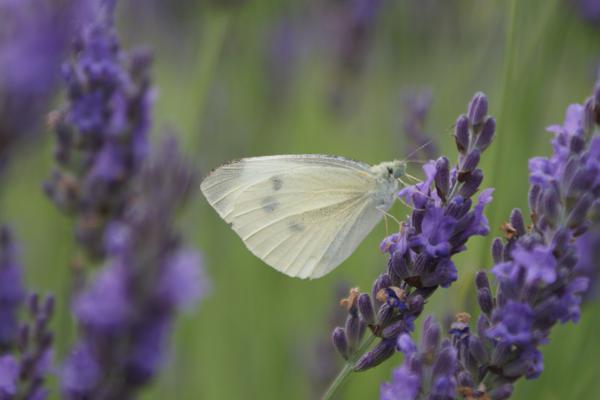Urban butterflies under threat of extinction

The study analyzed how the butterfly moves around in a city. © Alain Herzog/EPFL
According to an EPFL study, butterflies living in urban areas face the threat of consanguinity and potential extinction. The research drew on the fields of genetics and urban development to quantify the trend across an entire city.
“Our research illustrates what is probably a widespread phenomenon: a drastic reduction in biodiversity in urban areas. We were able to quantify this trend and show that it’s a problem that needs to be taken seriously,” says Estelle Rochat, a PhD student at EPFL’s Laboratory of Geographic Information Systems (LASIG).
 Looking at the densely populated Marseille region, Rochat measured the effect of urbanization on the genetic diversity of a particular species of butterfly, the small white (Pieris rapae, see on the left). She found that diversity fell by 60–80% in areas with a high urbanization rate, which means they have over 56% impervious land cover (i.e., land that has been developed with roads, buildings and other structures). In less dense neighborhoods, with between 3% and 13% impervious land cover, the loss in diversity was just 16–24%. Rochat also found that the butterfly population is 70–90% smaller in heavily urbanized areas. What’s more, butterflies that can fly only short distances seem to be more vulnerable to the effects of growing urbanization. Her research was recently published in Heredity.
Looking at the densely populated Marseille region, Rochat measured the effect of urbanization on the genetic diversity of a particular species of butterfly, the small white (Pieris rapae, see on the left). She found that diversity fell by 60–80% in areas with a high urbanization rate, which means they have over 56% impervious land cover (i.e., land that has been developed with roads, buildings and other structures). In less dense neighborhoods, with between 3% and 13% impervious land cover, the loss in diversity was just 16–24%. Rochat also found that the butterfly population is 70–90% smaller in heavily urbanized areas. What’s more, butterflies that can fly only short distances seem to be more vulnerable to the effects of growing urbanization. Her research was recently published in Heredity.
To quantify her findings, Rochat compared the results of a computer simulation with empirical data from a database of genetic information at Aix-Marseille University. She examined the DNA of a population of 145 butterflies in the Marseille region and compared it with simulated genetic data on 1,633 butterflies – spanning around 100 generations – of two species: the small white, which can fly up to four kilometers, and a less motile species that can fly up to two kilometers.
Resistance map
Using the genetic data, Rochat focused her thesis on species dispersal – the ability of a species to move around within a given area – and on the species’ ability to adapt to their environment. She started by entering characteristics about the small white’s movements into a software program. She also created a “resistance map” of Marseille by giving a resistance score to each part of the city based on its topography and how difficult it is for butterflies to move around within it. Areas with tall buildings or few parks and grasslands were given a high score, while those that could serve as butterfly habitats were given a low score. “We used the butterfly’s known behaviors to identify areas where they would be inclined to fly based on factors like vegetation and sunlight,” says Rochat.
Fragmented habitats
Rochat then compared the simulation results with data from the database of genetic information on butterflies that in 2010 had been located on a 100 km stretch of land extending from downtown Marseille to its outermost suburbs. Because her simulation results lined up with the data, she could extend her simulation to cover the entire city and thereby get a big-picture view. “We saw a huge difference in population persistence between downtown and the suburbs. Butterflies in highly urbanized areas had very little space to move around and it was harder for them to encounter other butterflies of the same species to reproduce. They showed a substantial degree of consanguinity, which reduces their ability to survive and adapt to their environment and could eventually lead to the disappearance of the species.”
Contiguous green spaces
A host of methods already exists for cities to maintain their biodiversity. Rochat notes that “roof gardens, urban gardens, grass planted between tram lines and flowers grown on balconies can all help prevent the habitats of certain butterfly species from fragmenting and disappearing. But a more sustainable approach is for urban planners to consider the impact that a new building will have on biodiversity before they build it, or to develop biodiversity regeneration plans.”
Stéphane Joost, one of the study’s co-authors, highlights the importance of linking up a city’s green spaces. “These days a lot of people are talking about urban farming and urban gardens. But it’s worth pointing out that these gardens play a key role in fostering urban biodiversity if – and only if – a city’s green spaces are contiguous with each other and with spaces outside the city,” he says. “Preserving biodiversity is also a major factor in improving urban dwellers’ quality of life, including the positive impact of a healthier environment on their well-being. That’s why policymakers and urban planners need to rethink the way they design downtown areas.”
Reference